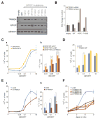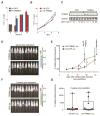TRIM24 Is an Oncogenic Transcriptional Activator in Prostate Cancer
- PMID: 27238081
- PMCID: PMC5124371
- DOI: 10.1016/j.ccell.2016.04.012
TRIM24 Is an Oncogenic Transcriptional Activator in Prostate Cancer
Abstract
Androgen receptor (AR) signaling is a key driver of prostate cancer (PC). While androgen-deprivation therapy is transiently effective in advanced disease, tumors often progress to a lethal castration-resistant state (CRPC). We show that recurrent PC-driver mutations in speckle-type POZ protein (SPOP) stabilize the TRIM24 protein, which promotes proliferation under low androgen conditions. TRIM24 augments AR signaling, and AR and TRIM24 co-activated genes are significantly upregulated in CRPC. Expression of TRIM24 protein increases from primary PC to CRPC, and both TRIM24 protein levels and the AR/TRIM24 gene signature predict disease recurrence. Analyses in CRPC cells reveal that the TRIM24 bromodomain and the AR-interacting motif are essential to support proliferation. These data provide a rationale for therapeutic TRIM24 targeting in SPOP mutant and CRPC patients.
Copyright © 2016 Elsevier Inc. All rights reserved.
Figures








Comment in
-
TRIM-ing Ligand Dependence in Castration-Resistant Prostate Cancer.Cancer Cell. 2016 Jun 13;29(6):776-778. doi: 10.1016/j.ccell.2016.05.014. Cancer Cell. 2016. PMID: 27300431
Similar articles
-
TRIM28 protects TRIM24 from SPOP-mediated degradation and promotes prostate cancer progression.Nat Commun. 2018 Nov 27;9(1):5007. doi: 10.1038/s41467-018-07475-5. Nat Commun. 2018. PMID: 30479348 Free PMC article.
-
Androgen receptor-dependent and -independent mechanisms driving prostate cancer progression: Opportunities for therapeutic targeting from multiple angles.Oncotarget. 2017 Jan 10;8(2):3724-3745. doi: 10.18632/oncotarget.12554. Oncotarget. 2017. PMID: 27741508 Free PMC article. Review.
-
Orphan nuclear receptor TLX contributes to androgen insensitivity in castration-resistant prostate cancer via its repression of androgen receptor transcription.Oncogene. 2018 Jun;37(25):3340-3355. doi: 10.1038/s41388-018-0198-z. Epub 2018 Mar 20. Oncogene. 2018. PMID: 29555975 Free PMC article.
-
GLI3 Is Stabilized by SPOP Mutations and Promotes Castration Resistance via Functional Cooperation with Androgen Receptor in Prostate Cancer.Mol Cancer Res. 2022 Jan;20(1):62-76. doi: 10.1158/1541-7786.MCR-21-0108. Epub 2021 Oct 5. Mol Cancer Res. 2022. PMID: 34610962 Free PMC article.
-
Androgen receptor: what we know and what we expect in castration-resistant prostate cancer.Int Urol Nephrol. 2018 Oct;50(10):1753-1764. doi: 10.1007/s11255-018-1964-0. Epub 2018 Aug 20. Int Urol Nephrol. 2018. PMID: 30128923 Review.
Cited by
-
TRIM24 promotes colorectal cancer cell progression via the Wnt/β-catenin signaling pathway activation.Am J Transl Res. 2022 Feb 15;14(2):831-848. eCollection 2022. Am J Transl Res. 2022. PMID: 35273688 Free PMC article.
-
Modulation of M2 macrophage polarization by the crosstalk between Stat6 and Trim24.Nat Commun. 2019 Sep 25;10(1):4353. doi: 10.1038/s41467-019-12384-2. Nat Commun. 2019. PMID: 31554795 Free PMC article.
-
Genetics and biology of prostate cancer.Genes Dev. 2018 Sep 1;32(17-18):1105-1140. doi: 10.1101/gad.315739.118. Genes Dev. 2018. PMID: 30181359 Free PMC article. Review.
-
Analyzing the Androgen Receptor Interactome in Prostate Cancer: Implications for Therapeutic Intervention.Cells. 2022 Mar 9;11(6):936. doi: 10.3390/cells11060936. Cells. 2022. PMID: 35326387 Free PMC article. Review.
-
BMP8A promotes survival and drug resistance via Nrf2/TRIM24 signaling pathway in clear cell renal cell carcinoma.Cancer Sci. 2020 May;111(5):1555-1566. doi: 10.1111/cas.14376. Epub 2020 Apr 7. Cancer Sci. 2020. PMID: 32128917 Free PMC article.
References
-
- Agoulnik IU, Vaid A, Nakka M, Alvarado M, Bingman WE, 3rd, Erdem H, Frolov A, Smith CL, Ayala GE, Ittmann MM, et al. Androgens modulate expression of transcription intermediary factor 2, an androgen receptor coactivator whose expression level correlates with early biochemical recurrence in prostate cancer. Cancer Res. 2006;66:10594–10602. - PubMed
Publication types
MeSH terms
Substances
Grants and funding
LinkOut - more resources
Full Text Sources
Other Literature Sources
Medical
Molecular Biology Databases
Research Materials

